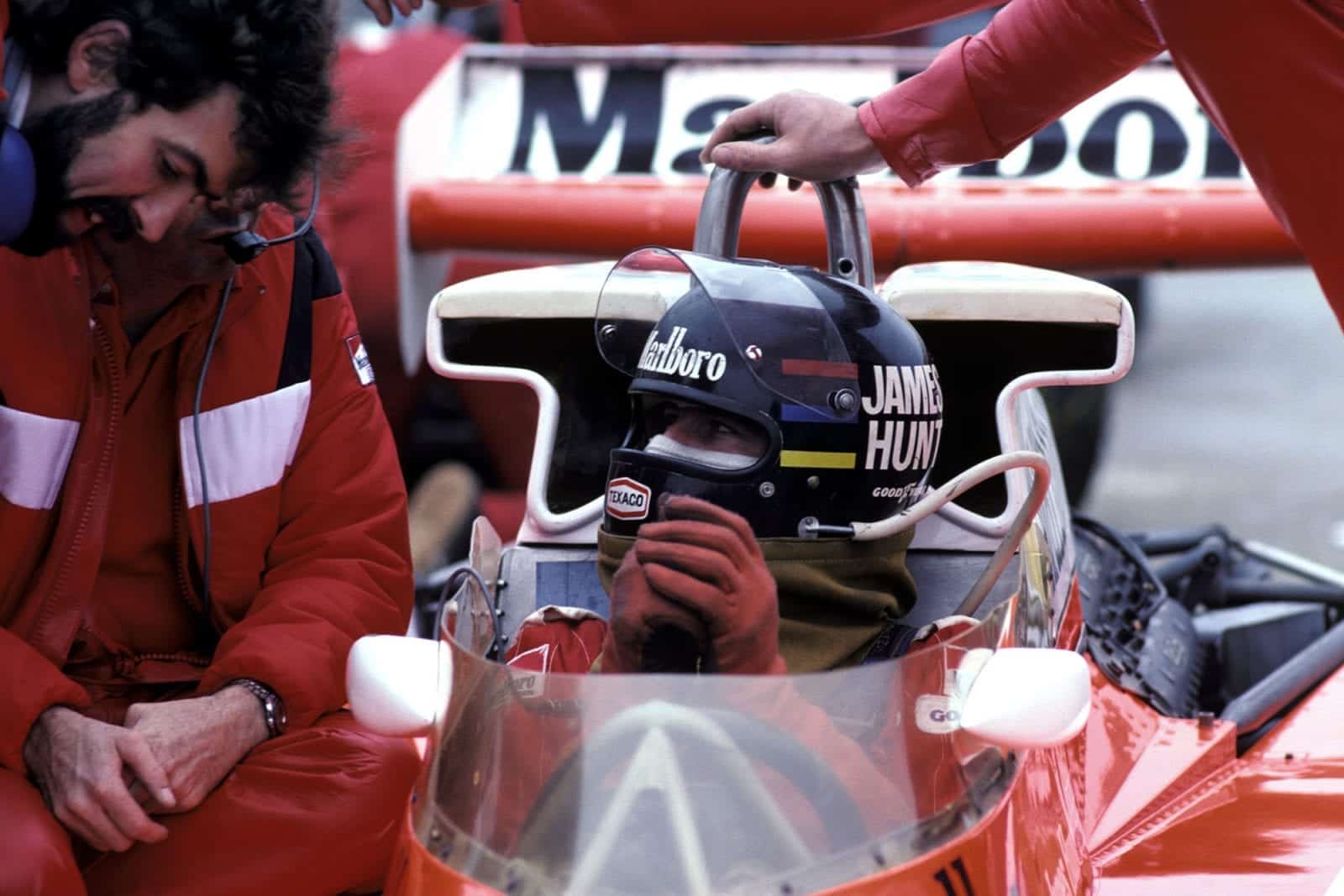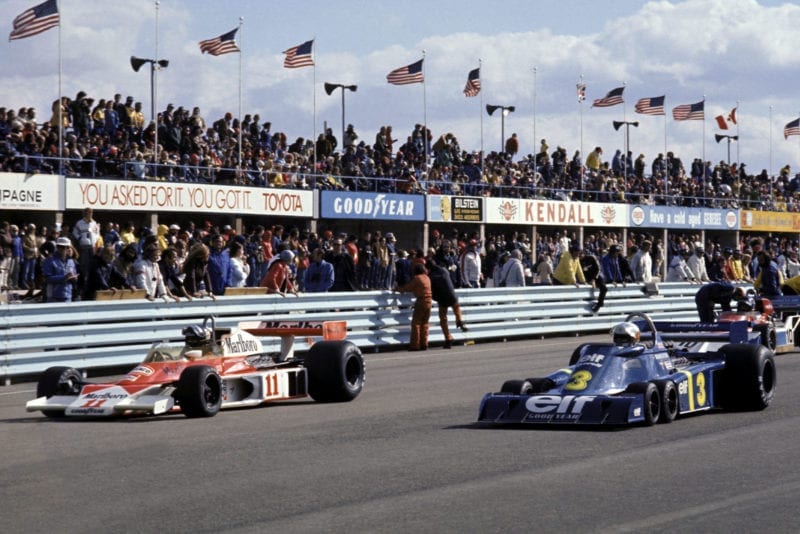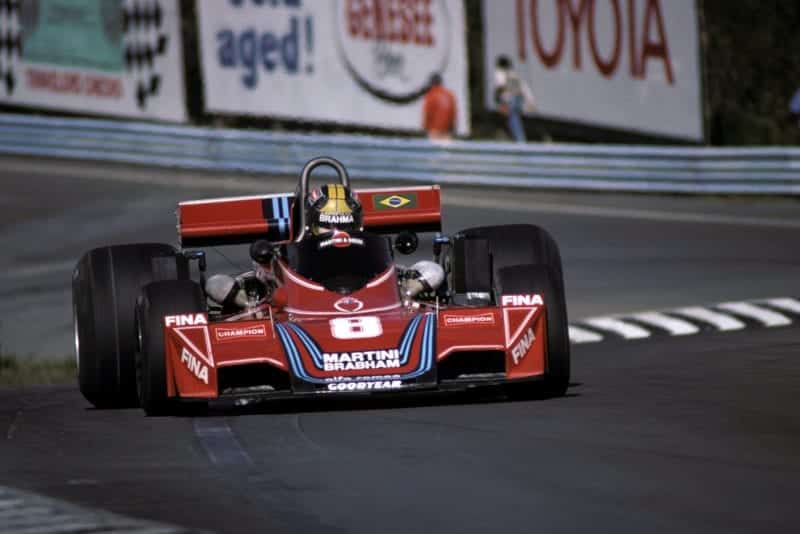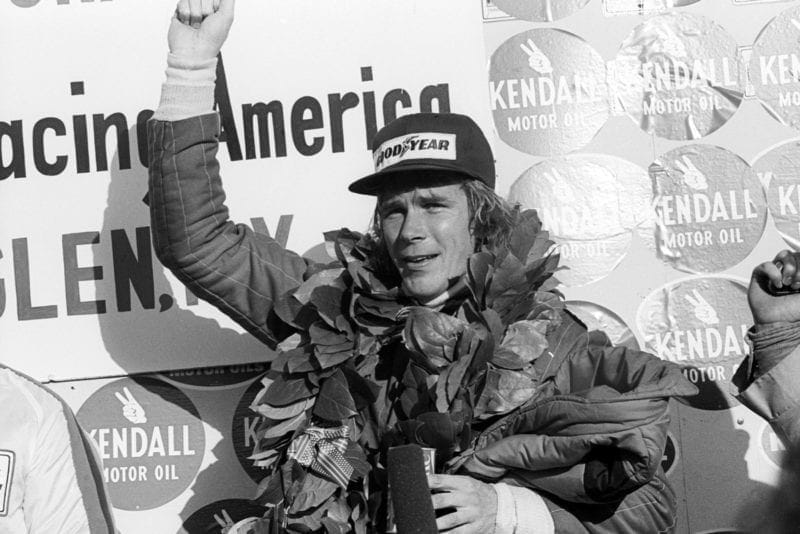1976 United States Grand Prix race report

James Hunt enjoyed a successful weekend by taking pole position, fastest lap and the race win at Watkins Glen
Motorsport Images
Hunt turns the screw
Watkins Glen, New York, October 10th
Immediately after the Canadian Grand Prix had ended, most of the Formula One teams loaded their cars onto giant lorries and moved “lock, stock and barrel” across the United States border into the State of New York to pitch camp in best circus style at Watkins Glen, the 3,4-mile circuit which is home of the United States Grand Prix. More precisely, it is the home of the United States Grand Prix as opposed to the home of the United States Grand Prix West which took place round the streets of Long Beach, California, last April. The United States became the first country to hold two World Championship Grand Prix races in the same year since Italy in 1957 (Pescara and Monza), this coming bout a peculiarity in the “yellow book” of rules which permits a country to hold two separate qualifying rounds in the World Championship series as long as they take place more than 3,000 miles apart. But the traditional home of the United States Grand Prix has always been at the wooded Watkins Glen circuit in the picturesque Fingers Lake region of New York-that’s if you can call “tradition” something which extends back a mere fifteen years to the first Formula One Grand Prix which came about after a move from the old Sebring airfield circuit after the 1960 race.
With only two days separating the end of the Mosport Park race with the opening of the Watkins Glen circuit for unofficial testing (on the Wednesday prior to the race), there wasn’t much time for the hard-worked mechanics to give their cars more than a “wash and brush up” although the Hesketh team put together a fresh machine for Harald Ertl to drive and the Wolf-Williams (or is it Williams-Wolf?) lads ferried out a fresh monocoque from Reading to rebuild Amon’s crashed car from Mosport. Both drivers involved in the Canadian practice accident were present at Watkins Glen on crutches, Amon with a nasty knee injury which prevented him from driving and Ertl with a cracked hip bone, despite which he was determined to have a crack at practising, at least. Guy Edwards decided that he wasn’t going to drive the Penthouse/Rizla Hesketh 308 and made off to new York “wheeling and dealing” for 1977, “renting” the vacant seat to the young March Formula Two charger Alex Arkell:Ribeiro who was having his first taste of Cosworth DFV power after a season grappling with 300 b.h.p. from a BMW 2-litre motor. Frank Williams spend one evening on the telephone at the Glen Motor Inn attempting to find a replacement for Amon, Michel Leclere declining (possibly he felt he knew enough about the car already having driven it in some early-season races!) and French Formula Two hopeful René Arnoux doing likewise. Frank then turned his attentions to California where he attempted to find Australian Vern Schuppan but instead found 1973 Tasman Champion Warwick Brown who agreed to come across to the other side of the country and drive the car. It was Brown’s first Formula One race after several seasons, both in America and Australasia, driving big V8-Chevrolet-powered Formula 5000 machines.
The official record for Formula one cars round Watkins Glen stands to Brazil’s Emerson Fittipaldi at 1 min 43.3 sec., established during last year’s race during his vain chase of Lauda’s winning Ferrari. Since that time there has been a minor alteration to the chicane which was incorporated into the circuit layout last year. The intention of the chicane had been to slow up cars as they approached the flat-out “Esses” where Tyrrell driver Francois Cevert was killed in practice for the 1973 United States Grand Prix, but in last year’s race it caused a great deal of trouble with drivers spinning sideways over its kerbs, sliding into the catch-fences and generally making a mess of their cars. This year the chicane was only slightly modified, the organisers quite rightly feeling that they’d done what the drivers had requested and now they didn’t feel particularly inclined to change it again.
Pre-race testing gave an interesting indication of what was to follow at the weekend with James Hunt taking his McLaren M23 round in 1 min. 42 sec., a full second faster that Lauda’s Ferrari according to the stop-watches operated by other interested teams. Mario Andretti (hoping for a win in his home Grand Prix), Patrick Depailler and John Watson were all bracketed between 1 min 43 sec. and 1 min. 44 sec. in Lotus, Tyrrell and Penske respectively, while Jacques Laffite was next in the all-French Ligier-Matra. Unfortunately this patriotic little team faced a major set-back when Laffite crashed chassis JS5/02 during this testing session and although the little Frenchman wasn’t injured, the car was badly damaged to put it out of cation of the rest of the week. Accordingly, Laffite was forced to use the team’s original car (JS5/01) ofr official practice and the race. Another surprise was seen in the form of Tyrrell driver Jody Scheckter having a “sneak preview” of the Walter Wolf financed team (for whom he’s signed to drive in 1977) by trying one of the Williams FW05s with the permission of Ken Tyrrell. Despite not fitting comfortably in the car, Scheckter lapped in a very respectable 12 min, 45 sec., which certainly put into perspective the efforts of the experienced Arturo Merzario. While nobody’s trying to pretend the FWO5 is the best formula One car in the world, it’s amazing what a “get-up-and-go” driver can do in place of all the whining and moaning that the tam’s previous drivers have regaled us with for most of the season!
Qualifying

Niki Lauda qualified his Ferrari 5th
Motorsport Images
Apart from the obvious issue of just who was going to win the United States Grand Prix that clouded matter of “the World Championship” also dominated the proceedings again. With only eight points separating James Hunt from Championship leader Niki Lauda, the McLaren driver had to win at Watkins Glen to make sure he retained a chance of taking the driver’s title in the final race of the series in Japan on October 24th. Unfortunately the fine autumn weather finally broke just before the start of official practice at Watkins Glen and Friday dawned with low cloud and driving rain lashing the circuit, saturating the thousands of campers who’d arrived to see the race and turning the whole area into a soggy mess.
Nevertheless, the circuit opened for the first session and everybody edged out on to the circuit to feel their way cautiously round. One of two of the “aces” were taking things a little easily to start with, not wanting to risk their cars on a saturated track during the first hour and a half, as it was almost certain to clear up for the subsequent sessions. But Hans Stuck took to the wet like the proverbial duck to water and roared his March 761 round in a cloud of spray to record 1 min. 57.751 sec. which looked as though it would stand as fastest in that session until Tom Pryce set a 1 min. 56.807 sec. best on his very last timed lap in the Shadow DN8. Other good times came from Niki Lauda (1 min. 58.998 sec.) but the whole affair was rather unrepresentative and the pattern completely changed once the circuit began to dry-out midway through the afternoon’s hour-long session.
Once it was time to go out on dry weather slicks, James Hunt immediately got down to business and very quickly established fastest time with a confident best of 1 min 43.622 sec. although Jody Scheckter, anxious for another Grand Prix victory before he leaves Elf Team Tyrrell, managed 1 min. 43.870 sec. in his P34 six-wheeler and Ronnie Peterson’s March stayed trouble-free for long enough for him to record 1 min. 43.941 sec. These three were the only drivers to break the 1 min. 44 sec. barrier and establish themselves in the “ace” category as far as Watkins Glen was concerned, although the two March directors present were smiling like Cheshire cats because Vittorio Brambilla was fourth with 1 min. 44.250 sec. and Stuck was sixth with 1 min. 44.265 sec., these two split only by Niki Lauda’s Ferrari which managed a best time of 1 min 44.257 sec. to qualify in fifth place. Although Ferrari had managed to get their number one driver well-placed in the practice times, Lauda was far from happy with the behaviour of his car and could be seen in agitated discussion with both engineer Forghieri and team manager Audetto about the “band handling” of the Italian car. Lauda’s main complaint surrounded what he described as the “lack of testing and development” while he was recovering from his accident.
John Watson tried his older chassis (PC4/01) after the failure of a front hub bearing on the newer machine while Patrick Depailler highlighted the session by being on the receiving end of the compressed air cylinder which McLaren use to activate the starter motor on their M23, Hunt’s car shedding his right in the middle of the circuit. The cylinder careered of the McLaren, badly bent two front wheels on one side of the Tyrrell six-wheeler and then glanced off Fittipaldi’s front anti-roll bar before gouging a great chunk out of the side of the Brazalian car’s monocoque. Nobody was injured in what could have been a very nasty incident, but souvenir hunters “bagged” the cylinder and were only persuaded to give it up on promises of various items of “James hunt regalia” by the harassed Clerk of the Course who went to retrieve it!
Tom Pryce couldn’t maintain the advantage he’d found in the very wet conditions, but his 1 min. 45.102 sec. was better than Carlos Pace in the faster of the two Brabham-Alfa Romeos, the Brazilian delighted with the BT45’s handling but disappointed with the Italian contribution to Ecclestone’s joint effort. Mario Andretti was waiting hopefully for Saturday to be dry, for he spent the whole of the first day setting up 77/R1 to his own personal liking and although he could only manage 1 min. 45.311 sec. he was burning with confidence. Larry Perkins put in a very respectable show in the second Brabham-Alfa Romeo, lapping faster than Clay Regazzoni who tried both his regular Ferrari and the spare (028-2) during the afternoon but really seems to have lost a great deal of his determination since he has been advised that Ferrari won’t be needing his services again in 1977. Both Fittipaldi and Jarier (Shadow DN5) were going better than ever, Mass felt his McLaren was set up too softly and Alan Jones put in a decent time (1 min. 46.402 sec.) to beat Ickx in the Ensign, Nilsson in the second Lotus and the other two Surtees of Lunger and Pescarolo quite convincingly. Herald Ertl made an appearance in the second session and just managed to lap quicker than the enthusiastic Ribeiro, despite his injured hip, while Brown was subsequently quicker than Merzario, but the little Italian’s Williams suffered gearbox trouble and, along with Pescrolo, wouldn’t have qualified for a start if the organisers hadn’t waived the 11- per cent qualifying rule. Stuppacher’s slow Tyrrell predictably failed to qualify either on grid order or percentage time.
Race

Hunt and Scheckter (right) line up on the grid
Motorsport Images
Despite hopes that the weather might brighten up on Saturday, the second day of official practice turned out to be worse than the first with torrential rain falling with such intensity that the organisers were worried that certain sections of the circuit might begin to subside, in which case they would have real trouble on their hands. All the cars and drivers stayed snugly in the Kendall Tech-Centre for most of the day until the organisers, desperately trying to give some sort of value for money to the bedraggled crowd, announced that the circuit would be open for an hour’s practice “if anyone wanted it”. March’s determined duo, Brambilla and Peterson decided to sally forth and see what conditions were really like, the Italian returning to the pits after a single lap. Peterson stayed out to do on flying lap before spinning on the straight while in second gear, knocking his March’s nose section off before retiring quietly back to the paddock garage. Nobody else even tried. The start, delayed almost an hour, took place under dry but cold conditions on Sunday afternoon and it was Scheckter who made the best start from his position on the left-hand side of the front row, gaining enough ground on Hunt to enable him to cut across onto the racing line for the first right-hand corner, leading the field through the chicane he’d helped to “design” and out down the long back straight. At the end of the first lap the blue Tyrrell was comfortably entrenched in the lead ahead of Hunt, Brambilla, Peterson, Lauda, Depailler, Watson, Andretti, Laffite, Pace, Regazzoni, Mass, Pryce, Perkins, Jones, Ickx, Nilsson, Fittipaldi, Ertl, Ribeiro, Pescarolo, Brown, Stuck (who made a nonsense at the start), Lunger and Jarier, the Frenchman trailing a long way behind after stalling the engine on the parade lap and being left on the grid.
It didn’t take long for Scheckter and Hunt to open an appreciable gap over their immediate pursuers for Brambilla was having quite a job with his March as a front tyre had begun to throw its tread on the warming-up lap and although it had been changed prior to the parade lap there wasn’t enough time to check it’s pressure properly. As a result the determined little Italian looked very untidy as he grappled with unexpected understeer and it took Lauda until the fifth lap before he’d carved a path through the traffic and could see a clear track in front of him. By that time Scheckter and Hund had done and the number one Ferrari was over 6 sec. behind the second place McLaren. Peterson began fading after a couple of laps with what appeared to be March’s usual nebulous “handling problems”, but when he pulled into the pits at the end of his 12th laps it was obvious that something was very seriously wrong. The left front wheel was leaning inwards at a peculiar angle as the front crossbeam which holds the top-end of both shock-absorbers had started to crack, so that was the end of the Swede’s race. Depailler had already dropped out of fifth place on his eight lap when a fuel line became disconnected on his Tyrrel and Merzario found himself spun off the track and out of the contest when Ertl ran into the back of him. The bearded Austrian made a quick pit stop for a new nose section to be fitted to his Hesketh and raced on near the back of the field.
As Lauda pulled away from Brambilla, vainly chasing the two leaders, the March man from Monza hung on grimly at the front of a tight bunch which now comprised Pace, Laffite, Regazzoni, Andretti and Mass with Stuck catching them fast. Pryce was next, all on his own in the Shadow DN8, and then came Perkins holding off Jones, Ickx and Fittipaldi in a tight quartet. Nilsson retired with engine trouble on lap 14, while a lap later Ickx crashed the Ensign very heavily as he came out of a left-hand corner at the back of the circuit. The car collided very violently with the double later guard rail, ripping off the front wheels and suspension which remained jammed under the barrier. The main portion of the car bounced back into the middle of the track, on fire, and Ickx miraculously climbed out and hobbled to the side of the circuit without help. He was taken to hospital where he was found to have a badly crushed foot, broken ankle and some minor burns. The whole business unsettled Scheckter, for not only did the Tyrrell driver almost collect the fire engine a couple of laps after the accident, but the South African was convinced the worse had happened to Ickx as the whole scene reminded him of Cevert’s crash three years earlier. Scheckter remarked later that it was very difficult to keep his mind on the race for a few laps, but he kept control and continue to lead Hund in confident style.

Carlos Pace (Brabham) crashed out on Lap 31
Motorsport Images
Jacques Laffite had scrambled his way past Brambilla on lap 12, the Ligier-Matra quickly pulling away to consolidate a safe fourth place. Andretti retired on lap 24 after clipping a kerb (his engine hadn’t revved properly from the start) and Mass moved in behind Pace in the queue immediately behind Brambilla. Perkins was eventually displaced at the head of his little group by Jones, the Surtees pulling away before the Brabham-Alfa retired on lap 31 when a front wishbone pick-up point pulled away from its mounting.
The next casualty was Lafitte, one of the Ligeir-Matra’s rear tyres virtually disintegrating as it sped down the long back straight, the resultant flaying rubber smashing up the suspension and scattering debris along the circuit behind it. Lafitte brought the car to rest without colliding with anything, but Brambilla picked up some of the wreckage and punctured a front tyre, so that meant that Jochen Mass was now fourth, running on his own.
On lap 36 Hunt moved right on to the tail of Scheckter’s Tyrrell, slipping past the six-wheeler a lap later and quickly opening a one second advantage. Unfortunately, Hunt’s spell at the front lasted just three laps and then McLaren was badly baulked as it lapped Brown’s slow Williams (which was handicapped by gearbox problems) at the chicane. Hunt was forced to slow up suddenly and Scheckter nipped past again as the Englishman sorted out his gears.
With 20 laps to go the order was thus: Scheckter, Hunt, Lauda, Mass, Stuck and Regazzoni with Watson pressing the sixth place Ferrari very hard indeed. Jones had passed Pryce’s Shadow which was now misfiring badly and eventually stopped with engine failure on lap 46 while Fittipaldi was next from the sensible Ribeiro with Ertl, Brown and Pescarolo still circulating several laps in arrears. With just over 13 laps left to go, Hunt pressed home a counter-attack on Scheckter, passing the Tyrrell on lap 46 before going away with an impressive spurt to beat the South African by just over 8 sec. as the chequered flag appeared after 59 laps’ racing.
In the closing stages of the race Lauda dropped to 55 sec. behind the second place Tyrrell and it looked as through Mass might catch him on the line. The German driver put his heart and soul into those last few laps, egged on by his enthusiastic mechanics who kept him well-informed of the gap. But Lauda was watching his rear-mirror like a hawk and just “let out the rope” enough to stay 0.05 sec. in front of the McLaren as they finished in nose-to-tail formation. Once rid of Regazzoni’s baulking, Watson closed in on Stuck but, like Mass, just failed to catch the man in front by less than a second. Lapped, Regazzoni finished seventh while Jones drove consistently to stay on the same lap as the Swiss and Fittipaldi was two laps down ahead of Jarier, Lunger and Ribeiro. Ertl completed 54 laps just ahead of Brown, the Australian driving the last few laps without third and fifth gears operative on the Williams but keeping out of everybody’s way as he did so. Lastly Pescarolo Completed 48 laps after a pit stop but that wasn’t sufficient to get him officially classified as a finisher.

Hunt celebrates his sixth win of the season
Motorsport Images
A delighted James Hunt celebrated with the McLaren team after his sixth official victory of the season (discounting Brands Hatch), more than any other driver/car combination. Nevertheless, the combined efforts of Lauda and Regazzoni had assured Ferrari of victory in the Constructors’ Championship, irrespective of what happens to the driver’s title in the final race at Japan’s Fuji circuit on October 24th. –A.H.
